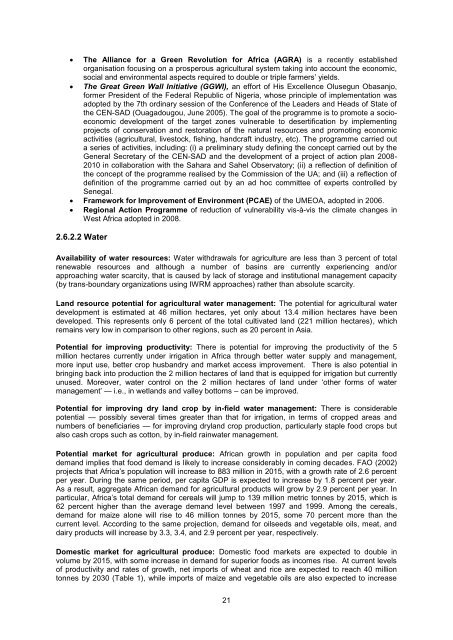The CAADP Pillar I Framework
The CAADP Pillar I Framework
The CAADP Pillar I Framework
- No tags were found...
You also want an ePaper? Increase the reach of your titles
YUMPU automatically turns print PDFs into web optimized ePapers that Google loves.
<strong>The</strong> Alliance for a Green Revolution for Africa (AGRA) is a recently establishedorganisation focusing on a prosperous agricultural system taking into account the economic,social and environmental aspects required to double or triple farmers‘ yields. <strong>The</strong> Great Green Wall Initiative (GGWI), an effort of His Excellence Olusegun Obasanjo,former President of the Federal Republic of Nigeria, whose principle of implementation wasadopted by the 7th ordinary session of the Conference of the Leaders and Heads of State ofthe CEN-SAD (Ouagadougou, June 2005). <strong>The</strong> goal of the programme is to promote a socioeconomicdevelopment of the target zones vulnerable to desertification by implementingprojects of conservation and restoration of the natural resources and promoting economicactivities (agricultural, livestock, fishing, handcraft industry, etc). <strong>The</strong> programme carried outa series of activities, including: (i) a preliminary study defining the concept carried out by theGeneral Secretary of the CEN-SAD and the development of a project of action plan 2008-2010 in collaboration with the Sahara and Sahel Observatory; (ii) a reflection of definition ofthe concept of the programme realised by the Commission of the UA; and (iii) a reflection ofdefinition of the programme carried out by an ad hoc committee of experts controlled bySenegal. <strong>Framework</strong> for Improvement of Environment (PCAE) of the UMEOA, adopted in 2006. Regional Action Programme of reduction of vulnerability vis-à-vis the climate changes inWest Africa adopted in 2008.2.6.2.2 WaterAvailability of water resources: Water withdrawals for agriculture are less than 3 percent of totalrenewable resources and although a number of basins are currently experiencing and/orapproaching water scarcity, that is caused by lack of storage and institutional management capacity(by trans-boundary organizations using IWRM approaches) rather than absolute scarcity.Land resource potential for agricultural water management: <strong>The</strong> potential for agricultural waterdevelopment is estimated at 46 million hectares, yet only about 13.4 million hectares have beendeveloped. This represents only 6 percent of the total cultivated land (221 million hectares), whichremains very low in comparison to other regions, such as 20 percent in Asia.Potential for improving productivity: <strong>The</strong>re is potential for improving the productivity of the 5million hectares currently under irrigation in Africa through better water supply and management,more input use, better crop husbandry and market access improvement. <strong>The</strong>re is also potential inbringing back into production the 2 million hectares of land that is equipped for irrigation but currentlyunused. Moreover, water control on the 2 million hectares of land under ‗other forms of watermanagement‘ — i.e., in wetlands and valley bottoms – can be improved.Potential for improving dry land crop by in-field water management: <strong>The</strong>re is considerablepotential — possibly several times greater than that for irrigation, in terms of cropped areas andnumbers of beneficiaries — for improving dryland crop production, particularly staple food crops butalso cash crops such as cotton, by in-field rainwater management.Potential market for agricultural produce: African growth in population and per capita fooddemand implies that food demand is likely to increase considerably in coming decades. FAO (2002)projects that Africa‘s population will increase to 883 million in 2015, with a growth rate of 2.6 percentper year. During the same period, per capita GDP is expected to increase by 1.8 percent per year.As a result, aggregate African demand for agricultural products will grow by 2.9 percent per year. Inparticular, Africa‘s total demand for cereals will jump to 139 million metric tonnes by 2015, which is62 percent higher than the average demand level between 1997 and 1999. Among the cereals,demand for maize alone will rise to 46 million tonnes by 2015, some 70 percent more than thecurrent level. According to the same projection, demand for oilseeds and vegetable oils, meat, anddairy products will increase by 3.3, 3.4, and 2.9 percent per year, respectively.Domestic market for agricultural produce: Domestic food markets are expected to double involume by 2015, with some increase in demand for superior foods as incomes rise. At current levelsof productivity and rates of growth, net imports of wheat and rice are expected to reach 40 milliontonnes by 2030 (Table 1), while imports of maize and vegetable oils are also expected to increase21
















